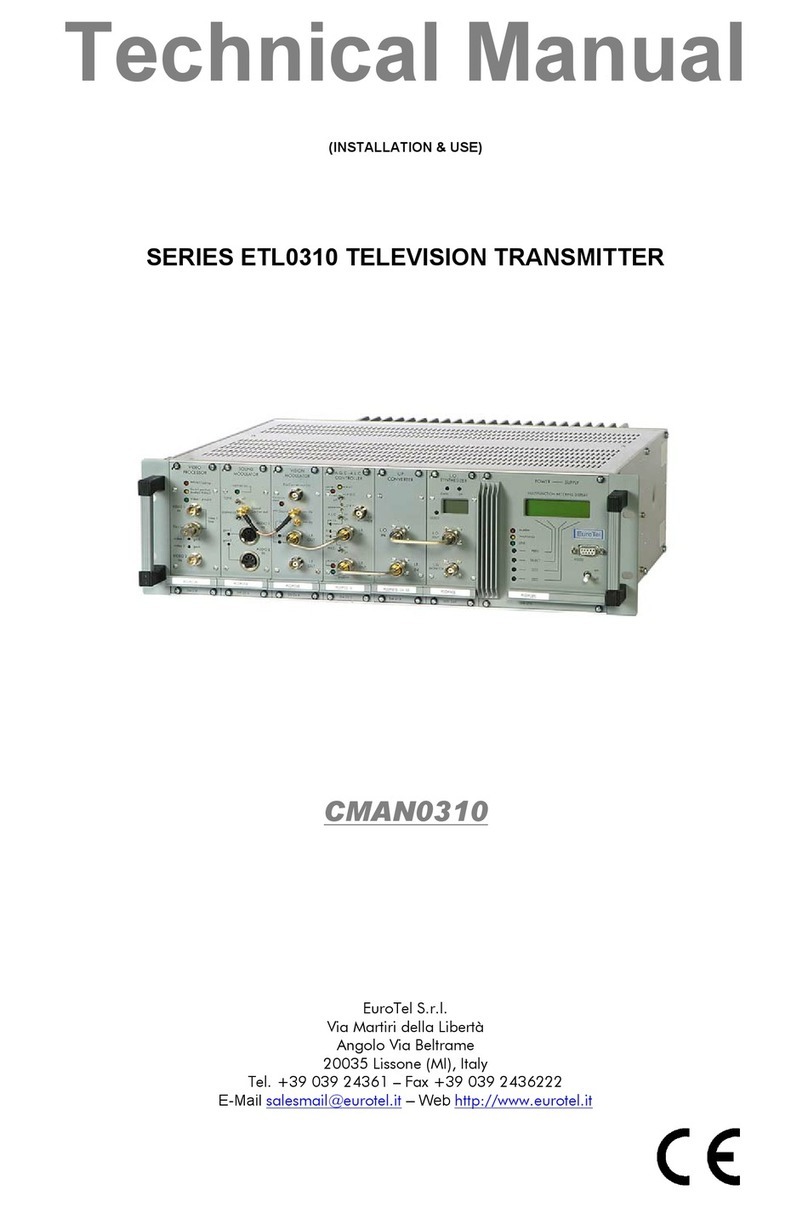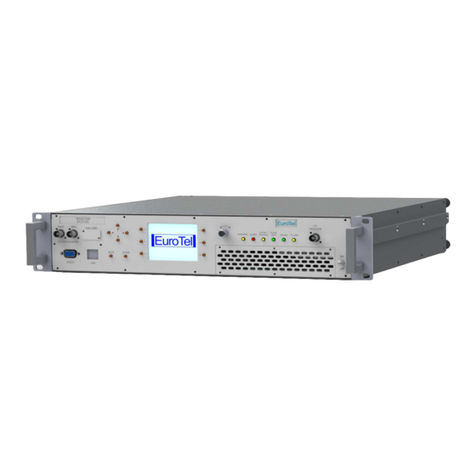EuroTel ETLUW4G03 User manual

Rev. 002 ETLUW4G03
Operating and Technical Manual
Operating and Technical ManualOperating and Technical Manual
Operating and Technical Manual
ETLUW4G03
ETLUW4G03ETLUW4G03
ETLUW4G03
2 kW (RM ) DTV / 5 kW ATV
2 kW (RM ) DTV / 5 kW ATV 2 kW (RM ) DTV / 5 kW ATV
2 kW (RM ) DTV / 5 kW ATV
UHF B IV-V LIQUID-COOLED TV TRAN MITTER
UHF B IV-V LIQUID-COOLED TV TRAN MITTERUHF B IV-V LIQUID-COOLED TV TRAN MITTER
UHF B IV-V LIQUID-COOLED TV TRAN MITTER
EuroTel .p.A.
Via Martiri della Libertà, 4
20851 Lissone (MB), Italy
Tel. +39 039 24361 – Fax +39 039 2436222
E-Mail [email protected] – Web http://www.eurotel.it
May 2013 CMANUW4G03 Page 1

ETLUW4G03 Rev. 002
Page 2 CMANUW4G03 May 2013

Rev. 002 ETLUW4G03
Operating and Technical Manual
Operating and Technical ManualOperating and Technical Manual
Operating and Technical Manual
2 kW (RM ) DTV / 5 kW ATV
2 kW (RM ) DTV / 5 kW ATV 2 kW (RM ) DTV / 5 kW ATV
2 kW (RM ) DTV / 5 kW ATV
UHF B IV-V LIQUID-COOLED TV TRAN MITTER ETLUW4G03
UHF B IV-V LIQUID-COOLED TV TRAN MITTER ETLUW4G03UHF B IV-V LIQUID-COOLED TV TRAN MITTER ETLUW4G03
UHF B IV-V LIQUID-COOLED TV TRAN MITTER ETLUW4G03
TABLE OF CONTENT
TABLE OF CONTENTTABLE OF CONTENT
TABLE OF CONTENT
Section A- GENERAL INFORMATION..............................................................................................5
I - AMENDMENT RECORD HEET............................................................................................5
II - APPROVAL RECORD HEET................................................................................................5
Section B- SAFETY INSTRUCTIONS...............................................................................................6
1 ) GENERAL IN TRUCTION ...........................................................................................6
2 ) AC LINE HAZARD ......................................................................................................6
3 ) RF HAZARD ...............................................................................................................7
4 ) FIRE RI K....................................................................................................................7
5 ) HANDLING BERYLLIUM OXIDE CERAMIC ..................................................................7
6 ) FIR T AID IN CA E OF ELECTRIC HOCK....................................................................8
7 ) EMERGENCY RE U CITATION: EXPIRED AIR METHOD................................................8
8 ) TREATMENT FOR BURN .............................................................................................8
Section C- SYSTEM DESCRIPTION, INSTALLATION AND TECHNICAL SPECIFICATIONS.......10
I - INTRODUCTION................................................................................................................10
II - FUNCTIONAL DE CRIPTION..............................................................................................10
III - ENERGY DI TRIBUTION AND COOLING...........................................................................13
IV - THEORY OF OPERATION OF ETLUW4G03 TV TRAN MITTER ............................................14
V - COMPO ITION OF ETLUW4G03 TV TRAN MITTER ...........................................................15
VI - IN TALLATION OF ETLUW4G03 TV TRAN MITTER............................................................16
1 ) ETLUW4G03 TV Transmitter: connections and module installation................................16
2 ) Other connections.......................................................................................................16
3 ) First time operation of ETLUW4G03.............................................................................17
VII - TECHNICAL PECIFICATION OF ETLUW4G03 TV TRAN MITTER.....................................19
1 ) General......................................................................................................................19
2 ) Output Parameters......................................................................................................19
3 ) Linear distortion..........................................................................................................19
4 ) Non linear distortion...................................................................................................19
Section D- MAINTENANCE & ALIGNMENT INSTRUCTIONS........................................................20
I - ETLUW4G03 TRAN MITTER UNIT........................................................................................20
1 ) Changing R.F. Output Power of the transmitter unit.......................................................20
2 ) Replacement and configuration of ETL0W474G R.F. Amplifier module..........................21
Section E- WEB INTERFACE............................................................................................................23
1 ) ummary WEB page...................................................................................................24
2 ) upervisor WEB page..................................................................................................25
3 ) Log WEB page............................................................................................................26
4 ) Amplifier WEB page....................................................................................................27
5 ) Liquid & Cooler Control Unit WEB page.......................................................................28
6 ) G M (option) WEB page..............................................................................................29
Section F- LAYOUT ASSEMBLY AND CIRCUIT DIAGRAMS.........................................................31
I - MAINFRAME AND WIRING DIAGRAM..................................................................................31
ETLUW4G03 WIRING DIAGRAM......................................................................................31
II - MAIN TRAN FORMER AND POWER DI TRIBUTION...........................................................33
1 ) chematic diagram.....................................................................................................33
May 2013 CMANUW4G03 Page 3

ETLUW4G03 Rev. 002
TABLE OF ILLUSTRATIONS
TABLE OF ILLUSTRATIONSTABLE OF ILLUSTRATIONS
TABLE OF ILLUSTRATIONS
Figure 1: ETLUW4G03 TV Transmitter – front view.......................................................................11
Figure 2: ETLUW4G03 TV Transmitter – rear view........................................................................12
Figure 3: ETL0W474G R.F. Amplifier module – rear view.............................................................13
Figure 4: ETLUW4G03 TV Transmitter - functional blocks diagram...........................................14
Figure 5: WEB interface - RF Output page.....................................................................................20
Figure 6: WEB interface - Login page.............................................................................................23
Figure 7: WEB interface - Summary page.......................................................................................24
Figure 8: WEB interface - Supervisor page....................................................................................25
Figure 9: WEB interface - Log page................................................................................................26
Figure 10: WEB interface - Amplifier page.....................................................................................27
Figure 11: WEB interface: Liquid & Cooler Control Unit page.....................................................28
Figure 12: WEB interface - GSM page.............................................................................................29
Page 4 CMANUW4G03 May 2013

Rev. 002 ETLUW4G03
ection A-
ection A-ection A-
ection A-GENERAL INFORMATION
GENERAL INFORMATIONGENERAL INFORMATION
GENERAL INFORMATION
I -
I - I -
I - AMENDMENT RECORD SHEET
AMENDMENT RECORD SHEETAMENDMENT RECORD SHEET
AMENDMENT RECORD SHEET
When an amendment to this publication is incorporated, the record below is to be completed and
initialed.
Release
ReleaseRelease
Release Language
LanguageLanguage
Language DE CRIPTION
DE CRIPTIONDE CRIPTION
DE CRIPTION AUTHORITY
AUTHORITYAUTHORITY
AUTHORITY DATE
DATEDATE
DATE
II -
II - II -
II - APPROVAL RECORD SHEET
APPROVAL RECORD SHEETAPPROVAL RECORD SHEET
APPROVAL RECORD SHEET
When an approval to this publication is incorporated, the record below is to be completed.
Release
ReleaseRelease
Release ignature
ignatureignature
ignature AUTHORITY
AUTHORITYAUTHORITY
AUTHORITY DATE
DATEDATE
DATE
© EUROTEL S.p.A.
© EUROTEL S.p.A.© EUROTEL S.p.A.
© EUROTEL S.p.A.
The inform tion cont ined herein is the property of EUROTEL S.p.A. nd is supplied without li bility
The inform tion cont ined herein is the property of EUROTEL S.p.A. nd is supplied without li bility The inform tion cont ined herein is the property of EUROTEL S.p.A. nd is supplied without li bility
The inform tion cont ined herein is the property of EUROTEL S.p.A. nd is supplied without li bility
for errors or omissions nd no p rt m y be reproduced, used or disclosed, except s uthorized by
for errors or omissions nd no p rt m y be reproduced, used or disclosed, except s uthorized by for errors or omissions nd no p rt m y be reproduced, used or disclosed, except s uthorized by
for errors or omissions nd no p rt m y be reproduced, used or disclosed, except s uthorized by
contr ct or other written permission. The copyright nd the foregoing restriction on reproduction, use
contr ct or other written permission. The copyright nd the foregoing restriction on reproduction, use contr ct or other written permission. The copyright nd the foregoing restriction on reproduction, use
contr ct or other written permission. The copyright nd the foregoing restriction on reproduction, use
nd disclosure extends to ll medi in which this inform tion m y be embodied, including m gnetic
nd disclosure extends to ll medi in which this inform tion m y be embodied, including m gnetic nd disclosure extends to ll medi in which this inform tion m y be embodied, including m gnetic
nd disclosure extends to ll medi in which this inform tion m y be embodied, including m gnetic
or electronic stor ge, etc.
or electronic stor ge, etc.or electronic stor ge, etc.
or electronic stor ge, etc.
May 2013 CMANUW4G03 Page 5
Table of contents
Other EuroTel Transmitter manuals
Popular Transmitter manuals by other brands

Geo
Geo Web Pack quick start guide

Inovonics
Inovonics EchoStream EN1210W installation instructions

IKONNIK
IKONNIK KA-6 quick start guide

Rohde & Schwarz
Rohde & Schwarz SR8000 Series System manual

Audio Technica
Audio Technica UniPak ATW-T93 Installation and operation

NIVELCO
NIVELCO EasyTREK SCA-300 Series Programming manual














